-
Paper Information
- Paper Submission
-
Journal Information
- About This Journal
- Editorial Board
- Current Issue
- Archive
- Author Guidelines
- Contact Us
International Journal of Information Science
p-ISSN: 2163-1921 e-ISSN: 2163-193X
2020; 10(1): 29-43
doi:10.5923/j.ijis.20201001.04
Received: July 30, 2020; Accepted: August 27, 2020; Published: September 3, 2020

Opportunities and Challenges of Coordinating the Implementation of e-Government Programmes in Zambia
1Department of Electrical and Electronic Engineering, School of Engineering, University of Zambia, Lusaka, Zambia
2Assistant Dean, Technical School of Engineering, University of Zambia, Great East Road Campus, Lusaka, Zambia
Correspondence to: Zondi Chilembo, Department of Electrical and Electronic Engineering, School of Engineering, University of Zambia, Lusaka, Zambia.
| Email: |  |
Copyright © 2020 The Author(s). Published by Scientific & Academic Publishing.
This work is licensed under the Creative Commons Attribution International License (CC BY).
http://creativecommons.org/licenses/by/4.0/

Information and Communication Technologies (ICTs) have significantly changed the way citizens interact across society and how governments operate and deliver services to its citizenry. The concept of e-Government has brought about efficiency and transparency in service delivery by working towards ensuring that inter-government coordination and collaboration are attained in the context of New Public Administration. Developing countries, Zambia inclusive, have undergone widespread deployment of e-Government initiatives, but experienced high failure rates because projects never got implemented. In some cases, projects were abandoned immediately after implementation or never achieved the intended outcomes requirements. One of the major challenges encountered in implementation of e-Government relates to coordination and collaboration among government agencies due to the failure to embrace change with preference to working in silos. The objective of this study was to look at opportunities and challenges of coordinating the implementation of e-Government programmes in Zambia. The study looked at the role played by the e-Government coordinating institutions and how effective inter-agency coordination and collaboration is in implementing e-Government programmes in the context of Zambia. In addition, various literatures were reviewed to appreciate the e-Government development stages and categorisation (Government to Government, Government to Employee, Government to Citizen and Government to Business), collaboration and coordination between the various government agencies and how other countries have successfully implemented e-Government programmes in a coordinated manner. The mixed survey research strategy was employed for this study with the focus on quantitative approach. However, qualitative method was used to gain more insights useful for interpretation of the results from the quantitative study. The research target was all government mqinistries and selected implementing agencies. A total of 120 questionnaires were distributed and 115 were responded to, representing a response rate of 95.8 percent. The primary data obtained from questionnaires were analysed using Statistical Package for Social Science (SPSS) and Excel. The summary of the research findings shows that 35 percent of the respondents indicated that the e-Government Coordination should reside in the Office of the President, 31 percent in the Ministry of Transport and Communication, 16 percent a new Ministry of Information and Communication Technology should be created and 6 percent were of the view that an ICT Agency should be established. 56% of the respondents indicated that there was no framework in place for inter-agency collaboration while 43% said there was a framework for inter-agency collaboration. In Zambia, several researchers and scholars have reviewed e-government implementation. However, there has been no study that has sought to review the role of coordination and inter-agency collaboration in implementing e-Government programmes in Zambia. This study therefore seeks to fill this knowledge gap looking at the opportunities and challenges of coordinating the implementation of e-Government programmes in Zambia. The results of this study will inform policy makers to come up with policies, strategies and legislative interventions that will make e-Government coordination and collaboration of government agencies more effective and transparent.
Keywords: e-Government, Coordination, Collaboration, Government to Government (G2G)
Cite this paper: Zondi Chilembo, Simon Tembo, Opportunities and Challenges of Coordinating the Implementation of e-Government Programmes in Zambia, International Journal of Information Science, Vol. 10 No. 1, 2020, pp. 29-43. doi: 10.5923/j.ijis.20201001.04.
Article Outline
1. Introduction
- e-Government is described as an interaction of government with citizens, public and private sectors by means of communication technology to provide services effectively and efficiently and to communicate with all parties interactively [1] or can be viewed as the administration, rules, regulations and frameworks organised by a government for service delivery as well as to communicate, coordinate and integrate processes within itself [2]. Additionally, e-Government helps in achieving greater efficiency in government performance by raising service performance, and service delivery through eliminating inefficient processes and reducing bottlenecks and red tape in the service delivery process as much as possible [3]. According to Nkwe (2012), a visit to government departments was viewed to be a nightmare characterised by a lot of paperwork, long queues, bureaucracy, cramped spaces, and frustrations [4]. It is a process of reform in the way governments work, share information and deliver services to external and internal clients [5]. Internal clients are employees, government departments and agencies while external clients are business entities and citizen.Studies by Heeks (2016, p3) suggest that the failure rate of e-Government projects in developing countries range between sixty (60) to eighty (80) percent resulting in wastage of financial, human and political resources and inability to deliver the potential benefits to its beneficiaries [6]. Heeks (2003) also reported that the implementation of e-Government initiatives in Sub-Saharan African countries had in most cases recorded failures, broken down as follows: 35% of e-Government projects in developing countries were a total failure, 50% were partial failures, while the remaining 15% were successful. The total failure projects referred to projects that never got implemented or were abandoned immediately after implementation while the partial failure projects were those that did not achieve the intended outcomes as per initial requirements. On the other hand, success projects are those that have attained the major goals and suffered less unintended outcomes [7]. These figures showed the need for research to be done to determine the challenges to the successful implementation of e-Government initiatives [8]. Other e-Government challenges encountered are associated with conflicting roles and responsibilities between the coordinating institution and implementing agencies. According to Mzyece (2012), e-Government initiatives failed to benefit citizens due to highly fragmented and uncoordinated approach in implementation [9]. This is because organisations want to continue to work in silos for fear of losing power if they collaborated with other agencies through a coordinating institution [10]. According to Estevez et al (2007), having a central coordination institution was key to promoting e-Government development within the public administration as it facilitated inter-agency collaboration. It promoted and gained acceptance across government agencies of the frameworks and standards to facilitate interoperability and efficiency. The central coordinating institution also helps to deal with setting technical standards, avoid duplication of efforts by individual agencies, increase information sharing, promote the use of government standards and policies, and facilitate centralised acquisition of ICT. This collaboration is a major requirement for efficient delivery of seamless online services and infrastructure products as well as effective successful ICT project implementation [11]. Historically, areas of shared responsibility for multiple government agencies have been resistant to real progress. However, leaders must also create in parallel the institutional and organisational processes that allow cross-agency actions to be sustained over time, such as formal agreements, defined roles and responsibilities, pooled resources, and shared performance goals. Collaboration has the potential to save money, simplify government for citizens and business and make public service more productive [12].Several researchers and scholars have reviewed e-Government implementation in developing countries. Nurdin et al (2014) study focused on local government e-Government systems implementation analysed from the perspectives of coordination and cooperation between internal and external actors and agencies [13]. Odat (2012) undertaken a study on the Impact of Collaboration and Coordination among e-Government: a case study of Jordan [14]. In Zambia, some of the studies undertaken on e-Government have addressed different aspects of the study area, for instance, Banda (2012) looked at Success and Failure of e-Government Projects in Developing Countries: the case of Zambia. Some of the findings showed that 66% of the respondents in his study were of the view that government agencies should take a leading role in promoting the e-Government initiatives followed by 26% who chose Public-Private Partnerships (PPP) [15]. Chipeta (2017) focused on Review of e-Government Development in Africa - a case of Zambia. The research findings revealed that 14% of telecommunication infrastructures was adequate to support the distribution of electronic services while 86% indicated that it was inadequate [16]. Bwalya (2007) observed in his research entitled Factors Affecting Adoption of e-Government in Zambia that usability, trust, and ICT infrastructure were the main impediments to e-Government adoption [17]. However, e-Government coordination and collaboration have not been paid much attention in research and a few studies have been undertaken focusing on coordination and inter-agency collaboration [18]. There has been no study undertaken on coordination and collaboration of implementing of e-Government programmes in Zambia. Therefore, this study looks at the opportunities and challenges of coordinating the implementation of e-Government programmes in a developing country (Zambia) considering the effectiveness of inter-agency collaboration in implementing e-Government programmes in Zambia.
2. Categorisation and Interaction of e-Government
- e-Government can be broadly categorised into the following: Government to Business (G2B), Government to Citizen (G2C), Government to Employee (G2E) and Government to Government (G2G). G2B focuses on the relationship that exists between the government and its agencies on the one hand and the business community on the other. G2C deals with the establishment of an electronic interface to enable a two-way communication channel between the government and citizens. G2E focuses on relationships within government among employees to coordinate internal operations and improve the internal efficiency of business processes. G2G refers to online communication amongst government organizations, departments, and agencies.Undoubtedly, there has been no consensus of thought within the academic and research community on the broad levels of e-Government interactions. Others advocate a three-level categorisation placing Government-to-Employee classification under the Government-to-Government umbrella because employees are part of the government and cannot sufficiently constitute a separate entity in an e-Government interaction model. Titah and Barki (2006) suggested that apart from organisational factors, individual beliefs of citizens have a significant influence on the adoption of e-Government services [19].Among these four groups, G2C and G2E involve interaction and cooperation between government and individuals, while G2B and G2G address the interaction between government and organisations. Moreover, G2C and G2B represent the external interaction and collaboration between government and outside institutions, while G2E and G2G involve the internal interaction and cooperation between government and government employees, as well as between government at different levels and at different locations [20] as shown in Figure 1 below.
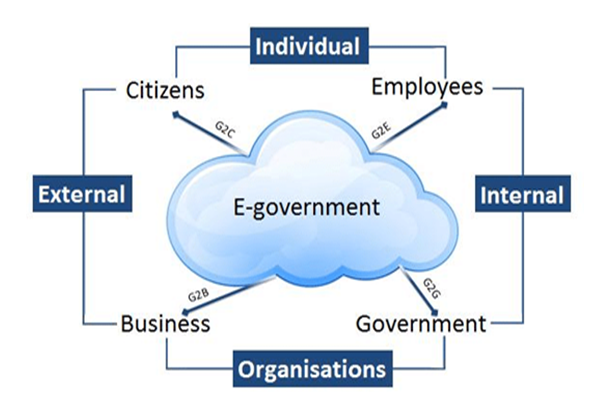 | Figure 1. e-Government Categorisation and Interaction (Siau and Long, 2018) |
2.1. e-Government Stage Models
- Several e-Government stage models have been proposed and developed either by individual researchers (e.g. Hiller and Belanger (2001); Layne and Lee (2001); Moon (2002) or by institutions for example: United Nations and American Society for Public Administration (2001); Baum and Di Maio (2000); Gartner Group Deloitte and Touche (2001).This study looked closely at two models which includes the followingGartner four stage group that include (i) Web Presence – Government/agencies provide a website to post basic information to public; (ii) Interaction – Users are able to carry out simple self-service such as downloading documents from Ministries/agencies websites; (iii) Transaction - users (including customers and businesses) are able to complete entire transactions (e.g. license application and procurement) online; and (iv) Transformational - Governments transform the current operational processes to provide more efficient, integrated, unified, and personalised service – seamless [23]. United Nations and American Society for Public Administration (UNASPA) 2001 development stage model includes (i) Emerging presence – a single or a few independent government websites provide formal but limited and static information; (ii) Enhanced presence – Government websites provide dynamic, specialised, and regularly updated information; (iii) Interactive presence – Government websites act as a portal to connect users and service providers. The interaction takes place at a more sophisticated level; (iv) Transactional presence – users are able to conduct complete and secure transactions, e.g. obtaining passports, through a single government website; and (v) Seamless or fully integrated presence – Government utilise a single and universal website to provide a one-stop portal in which users can immediately and conveniently access all kinds of available services.
2.2. Coordination and Collaboration
- Coordination and collaboration are a key ingredient in facilitation of effective implementation of e-Government. Coordination helps clarify the actors’ responsibilities across government organisations and departments [24] and can result in harmonious task completion. In short it helps government ministries/agencies achieve jointly determined goals. e-Government development also requires coordination to bring improvements and enable the delivery of services through integrated one-stop shops, whether virtual or physical [25]. Coordination has both positive and negative connotations. Positively, it means bringing about collaboration and teamwork among the persons and units of an organisation. Negatively, it means removing conflicts, inconsistencies, friction, overlapping, and working at cross purposes among persons or units of an organisation [26]. Coordination institution however need to be able to rely on a formal authority in case collaboration fails [27].According to UNESCO (2019), coordination can either be horizontal or vertical. Horizontal coordination targets primarily central government ministries and bodies [28]. Additionally, many service delivery processes transcend departmental and organisational boundaries and a client’s question often does not follow organisational boundaries [29]. Horizontal coordination can also be described as coordination between organisations on the same level (e.g. different ministries on the federal level), known as “joined-up government”, a concept firstly introduced by the Tony Blair led British government in 1997 as whole-of-government [30] [31] [27]. Vertical coordination is concerned with linking national and sub-national levels to guarantee joined-up and sustainable implementation and management of inclusive policies [28]. Vertical coordination has improved due to reforms associated with New Public Management (NPM), which generally focus on performance management, structural devolution and “single-purpose” organisations [32] [33] [27]. This for example is reinforced by a study by Nurdin et al (2014) which modelled coordination and collaboration around the case study at Jembrane Regency (local government level) showing how it is linked to central government and lower layers in supporting e-Government implementation.Christensen and Laegreid (2008) and Wojtarowicz and Herold (2014) state that vertical and horizontal coordination can be viewed from internal and external dimensions. Internal dimension refers to coordination within the central government, while external coordination takes place between central government (e.g. ministries) and organisations outside the government (e.g. NGOs, private sector).
|
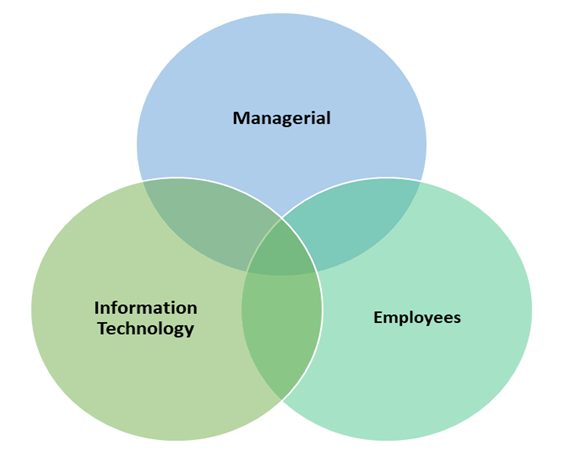 | Figure 2. Collaboration Model (Odat, 2012) |
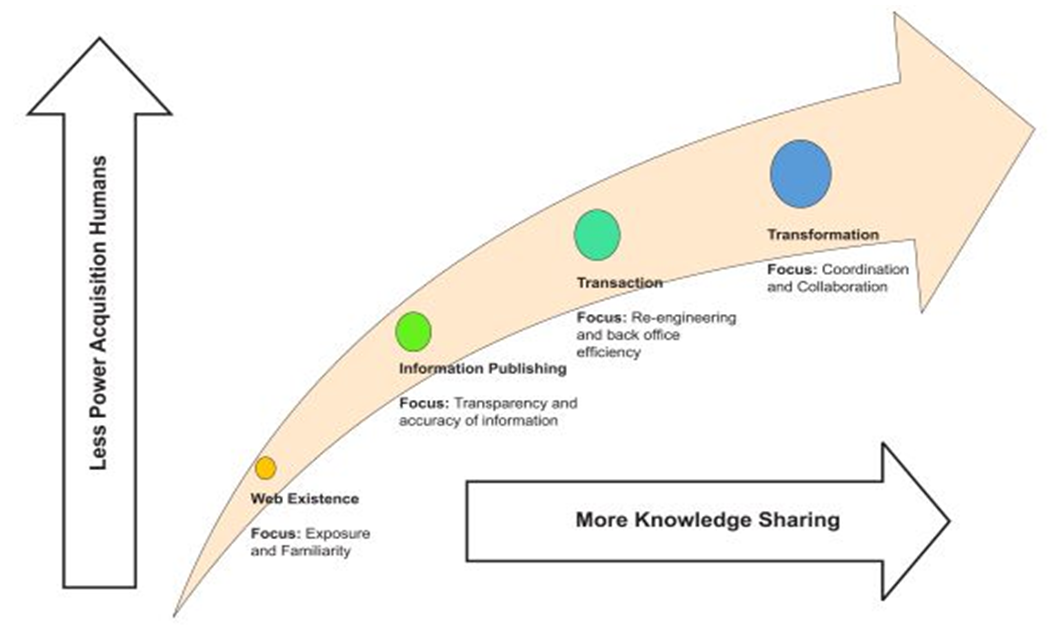 | Figure 3. e-Government focus evolutionary model (Abu-Shanab & Shehabat, 2018) |
2.3. e-Government Coordination Institutions
- A number of studies have been undertaken to look at institutional models of coordination (OECD 2005; Hanna et al. 2009; and Estevez et al. 2007) and some of the conclusions made is that there is no ‘one size fits all” solution to the question of how best to coordinate e-Government. As much as governments share common challenges, they start from different places in terms of e-Government and administrative development. e-Government coordinating models can either lean more on the administrative control or more on the political control [39]. Many countries have made e-Government a specific portfolio to ensure that national infrastructure is in place, push lagging agencies and promote interoperability through common standards. In instances where e-Government portfolio exits or resides in several ministries is a clear indication that e-Government does not have a natural home. Both administrative and political control can be wielded to ensure cross agency coordination [39]. Placement of e-Government responsibility in or near the center of administrative and political control does seem to have a symbolic value in terms of visibility and as a display of political will. For example, the elevation of e-Government to “presidential priority” in the United States of America in 2002 accompanied by creation of the position within the Executive Office of the President.According to the report by Infodev/World Bank (2009), on e-Government Primers, five (5) different models of organising leadership for any kind of e-Development (including e-Government) are evident [40] and include the following: • The shared responsibility model, in which each ministry or department develops and implements its own strategy.• The policy coordination model, in which a policy coordination body situated in the office of the head of state provides policy guidance and coordination.• The lead ministry model, in which one ministry develops plans. • The ICT (or e-Government) agency in civil service model, in which a special purpose agency is created outside of any ministry.• The ICT (or e-Government) agency as PPP (public private partnership) model.Another study by Hanna et al (2009) show similarities with the study by infodev/world bank with the institutional coordinating models being broken as follows: policy and investment, administrative, technical, and shared or no coordination [26]. Different countries are coordinating e-Government in different ministries or setups. For example, Rwanda has its coordination under policy and investment models while Kenya under Technical Coordination as shown in table 2 below:
|
3. e-Government Journey in Zambia
- The journey for Zambia can be traced back to 1968 when government established the Centralised Computer Services Department (CCSD) to provide data processing services to public institutions. With time, technology and usage of ICT significantly changed but CCSD, did not evolve and was unable to effectively coordinate and regulate the adoption and application of ICTs in Ministries Province and Spending Agencies (MPSAs), partly due to its inappropriate institutional arrangement and inadequate organisational structure [41]. CCSD was department under the Ministry of Finance. Following approval and adoption of the National ICT Policy in 2006, the Department of Communication commenced spearheading the implementation of e-Government programme in line with the National ICT policy [42] side by side with CCSD. In 2014, Government found it necessary to transform CCSD into a Centre of Excellence for e-Government and ICT (CEEGICT) to facilitate implementation of e-Government as well as coordinate and support ICT in the Public Service, which was lacking. This was done in line with the 2006 policy provisions under the e-Government pillar. One of the issues highlighted under this pillar was establishment of an e-Government Centre of Excellence. This was meant addressed challenges that had persisted as several Ministries had continued to operate ICT systems within their headquarters and in outlying areas. On the other hand, CCSD which was supposed to provide support to systems in the ministries was not appropriately structured. In short, it lacked the necessary control and oversight over the systems developed in public service. Ministries established independent ICT infrastructure and systems and necessitated duplication of public ICT resources across the country targeting the same citizens [41]. For example, Integrated Financial Management Information System (IFMIS) project was developing network infrastructure and Payroll Management and Establishment Control (PMEC) system also had a parallel network infrastructure being developed. On 22nd October 2015, the President of Republic of Zambia, Dr Edgar Chagwa Lungu established the e-Government Division, CEEGICT and placed it under the Office of the President. The President further re-emphasised his commitment to e-Government during his address to Parliament in September, 2016 on the need for Zambia to embrace a transformative culture by embracing innovation and entrepreneurship; embracing technology to simplify and quicken provision of services; re‐aligning institutions, where necessary, to make them more responsive to the needs of the nation; promoting cost effective operations in government to eliminate waste and abuse of public resources; transitioning towards a green economy; creating SMART institutions and SMART budgeting that promote a whole‐of-government approach to public service delivery; and promoting punctuality and efficiency to enhance productivity [43].In 2016, CEEGICT changed its name through Government Gazette notice No 836 of 2016 to SMART Zambia Institute (SZI). Its overall mandate is coordination and implementation of Information and Communication Technology (ICT) and e-Government in the Public Sector. Its core mandate is to integrate ICT infrastructure platform for G2C, G2G and G2B services, coordinate and standardise the deployment of ICT and e-Government services [44]. The President of Republic of Zambia further elevated the Position of e-Government National Coordinator (Permanent Secretary) to Deputy Secretary to the Cabinet. Figure 4 below shows the timeline of the ICT and e-Government reforms that have taken place from 1968 to 2017.
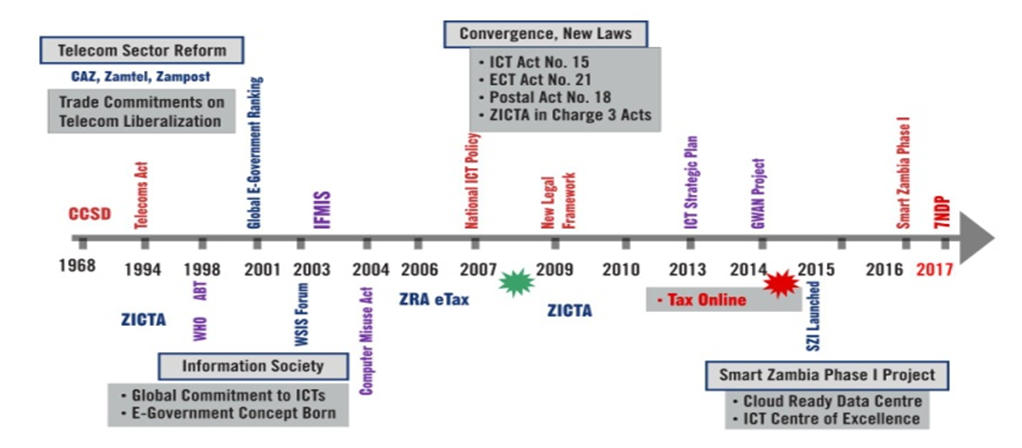 | Figure 4. The ICT and e-Government timelines (SZI, 2019) |
3.1. e-Government Legislation
- In 2009, pieces of legislation where enacted in line with the ICT policy. These include: The Information and Communication Technologies (ICT) Act No. 15 of 2009 which provides for the economic and technical regulation of Information and Communication Technology and establishment of the ZICTA renamed after Communication Authority of Zambia (CAZ) [46]. The Electronic Communications and Transactions (ECT) Act No. 21 of 2009 that provides for the development of a safe, secure, and effective environment for the consumer, business sector and the Government to conduct and use electronic communications [47]. The Universal Access and Service Fund Regulation No. 38, 2012 which promotes the widespread availability and usage of electronic communication services throughout Zambia, and to bridge the digital divide between urban, peri-urban, and rural areas [48] in line with the ICT Act of 2009 that provides for the establishment of a Universal Access and Service Fund to address the provision of electronic communications services in un-served or under-served areas and communities. In 2018, The Information and Communications Technology Association of Zambia Act No. 7 of 2018 was enacted to provide for the registration of information and communications technology professionals and to regulate their professional conduct in the interest of the information and communications technology sector [49].The Ministry of Transport and Communications also indicated that Government would introduce three bills in Parliament upon approval by Cabinet in principle. Three bills are Cybercrime and Security, Data Protection, and e-Commerce bills. These bills are yet to be presented to parliament for enactment [50].
3.2. e-Services
- As part of the e-Government transformational agenda, government has deployed online platforms for selected public services to simplify and quicken service delivery. Among those deployed are Integrated Financial Management Information System (IFMIS), e-Voucher, Electronic Cabinet (e‐Cabinet) which facilitates processing of cabinet business paperless; Zambia Integrated Agriculture Management Information System (ZIAMIS); Zambia Integrated Land Management information System (ZILMIS) provides for land acquisition, titling, survey data and payment modules, Electronic Payslip System that provides government workers payslips electronically; Treasury Single Account facilitates electronic payments to suppliers of products and services to government and government employees cutting off issuance of cheques and reduction in human contact; Zambia Immigration Management System which provides for issuance of electronic visas to tourists; Electronic Government Procurement System provision of electronic tendering and bidding, Tax Online Administration facilitates processing of tax payment, electronic returns, Patents and Company’s Registration that provides for online registration of businesses and electronic returns among others. However, these are being implemented in the public sector with very little coordination and integration with existing systems.
3.3. Ranking on Global Index
- The e-Government Development Index (EGDI) assesses e-Government development at the national level, using a composite index based on the weighted average of three normalised indices namely: Telecommunications Infrastructure Index (TII) based on data provided by the International Telecommunications Union (ITU), Human Capital Index (HCI) based on data provided by the United Nations Educational, Scientific and Cultural Organisation (UNESCO), and Online Service Index (OSI) assesses the national online presence of all 193 United Nations Member States. Africa has continued to lag infrastructure wise, including broadband infrastructure and access to broadband services. On the EGDI Report of 2018, the rankings of some countries doing well in Africa are Mauritius (66th), South Africa (68th) Tunisia (80) and Seychelles (83) in the top 100 and with EDGI level rated high. Zambia’s performance on EGDI was ranked 133 in 2018 compared to 2016 132 in 2016 improving by one place. In terms of the e-Participation Index, the country was ranked 132 in 2018 maintaining the same position as in 2016. [51].
4. Methodology
- The mixed survey research strategy was employed for this study with the focus on quantitative approach. However, qualitative methods were used to gain more insights useful for interpretation of the results from the quantitative study. The research target was all government Ministries and selected implementing agencies. A total of 120 questionnaires were distributed and 115 were responded to representing a response rate of 95.8 percent. Participants were purposively selected and included Head of ICTs, ICTs Officers and Heads of Planning Departments and Planners. The researcher also used secondary data to gain more understanding and gather adequate information about the area of study.The primary data obtained from questionnaires were analysed using Statistical Package for Social Science (SPSS) and Excel.
5. Results
- The findings were categories into three broad areas namely: Demographic Information, Institutional Coordination Opportunities, and e-Government Coordination and Collaboration Challenges.
5.1. Demographic Information
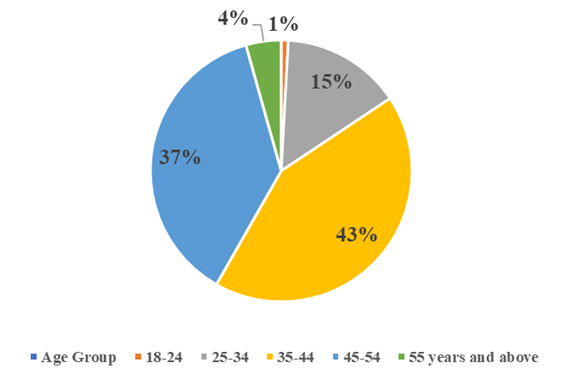 | Figure 5. Respondents by Age Group |
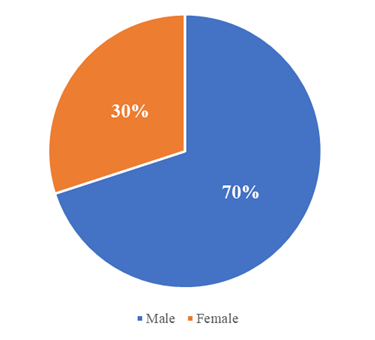 | Figure 6. Respondents by gender |
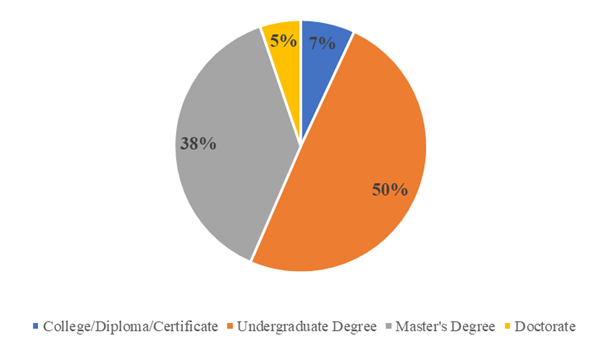 | Figure 7. Respondents by highest Level of Education |
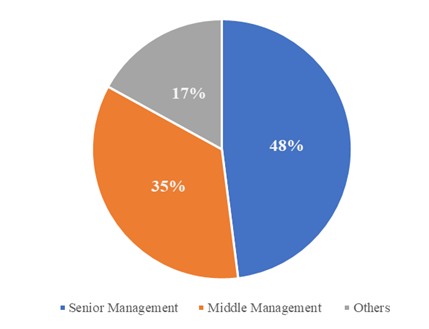 | Figure 8. Respondents Level of Management |
5.2. Institutional Coordination Opportunities
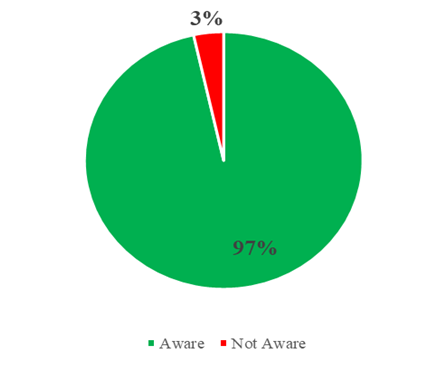 | Figure 9. Awareness on e-Government Coordinating Institution |
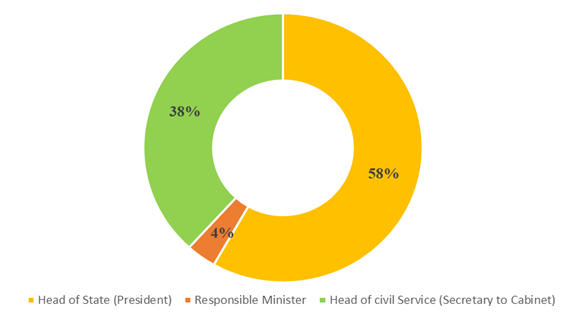 | Figure 10. e-Government Reporting Arrangement |
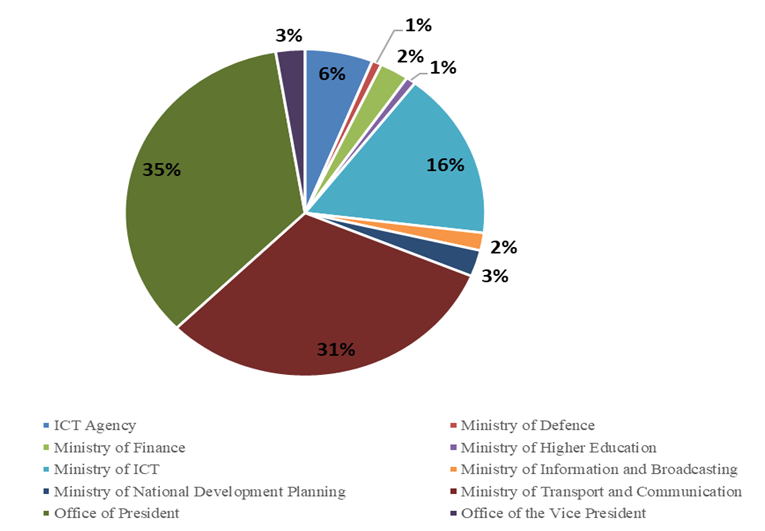 | Figure 11. Preferred location for e-Government Coordination Institution |
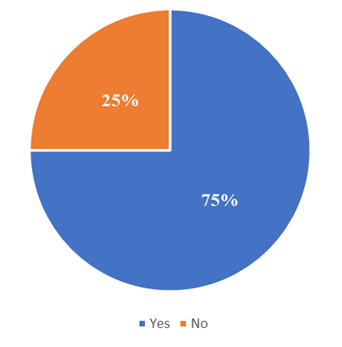 | Figure 12. Project requiring data input from other government systems (Database) |
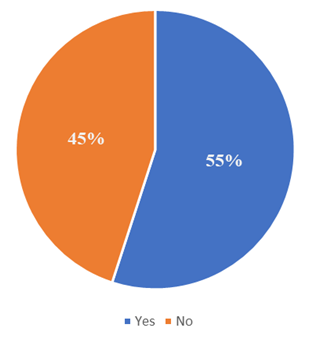 | Figure 13. Increased Collaboration in Project Implementation |
 | Figure 14. Setting ICT Standards |
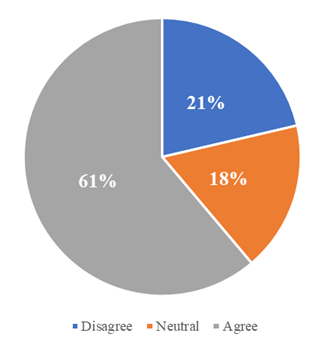 | Figure 15. Provision of Technical Support |
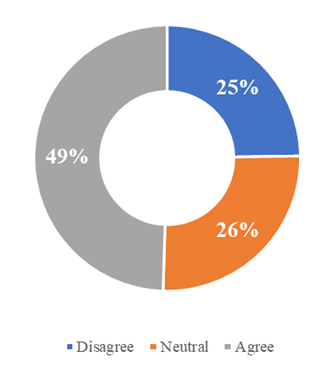 | Figure 16. Approving ICT Projects |
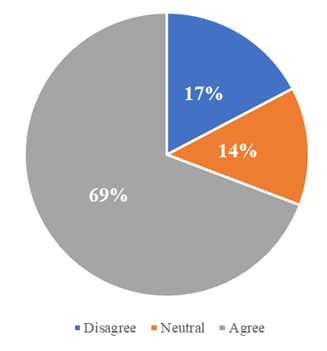 | Figure 17. Provision of Shared Infrastructure |
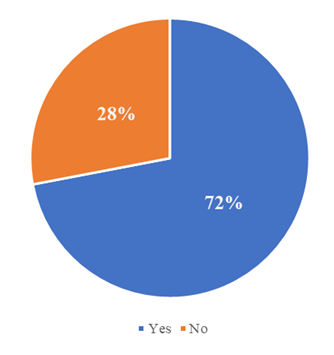 | Figure 18. Strong leadership and commitment to implement e-Government Programmes |
5.3. eGovernment Coordination and Collaboration Challenges
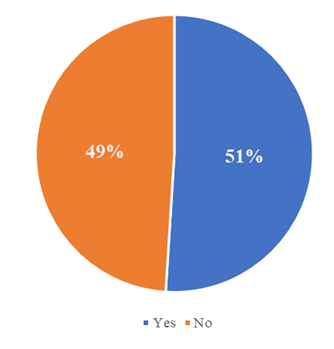 | Figure 19. e-Government Legislation in place for coordinated implementation |
 | Figure 20. e-Government strategy in place for coordinated implementation |
 | Figure 21. Framework for Inter-Agency Collaboration |
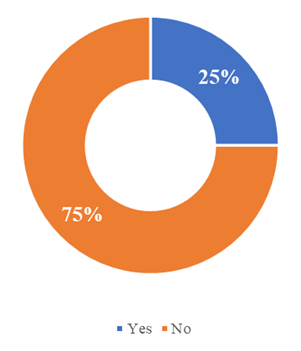 | Figure 22. Availability of Legislation to enforce Interoperability |
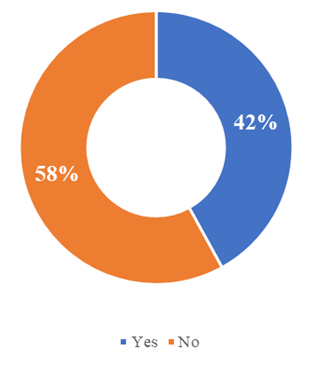 | Figure 23. e-Government change process from manual to e-Services |
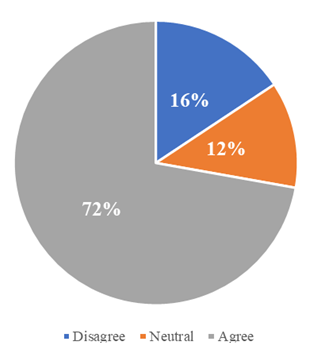 | Figure 24. Insufficient budgetary allocation for e-Government programme/projects |
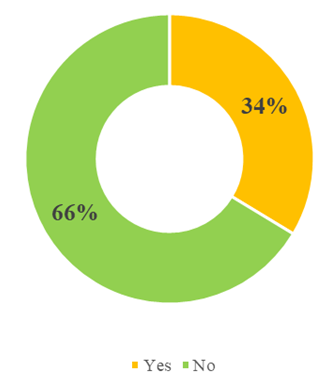 | Figure 25. Provision of Online Transaction |
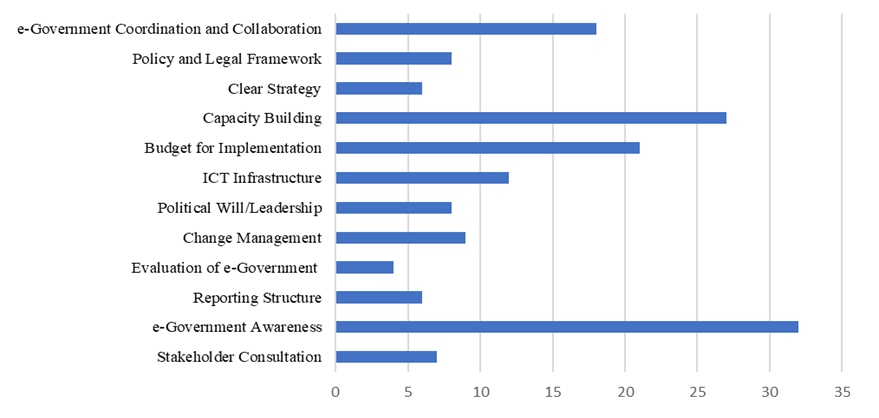 | Figure 26. Perceived Challenges by Respondents |
6. Discussion
- The study showed that majority of the respondents were aware of existence of an institution responsible for coordinating e-Government programme implementation. It also highlighted that those in senior management where more aware of existence of legislation and strategy when the information was cross referenced. This shows that more work needs to be done to ensure that those at lower levels of management are aware of the legislation and strategy for implementing e-Government programmes. Most of the respondents were of the view that the e-Government coordinating institution should remain in the Office of the President due to the authority and power the office possesses while others indicated that the Ministry of Transport and Communication was better placed since the mandate of the ICT Policy was with this ministry. This resonates with other studies done by OECD (2005) and Estevez et al (2007) on institutional modes of coordination that concluded that there is no ‘one size fits all” solution to the question of how best to coordinate e-Government. The study shows that Zambia has adopted the Administrative Model for e-Government Institutions that facilitates integration of administrative simplification and reforms into e-Government. However, this model may lack the technical expertise required to coordinate e-Government or the financial and economic knowledge to set priorities.Further the study showed that most of the respondents indicated that the coordinating institution reports to the President while others said to the Secretary to the Cabinet. This shows that both administrative and political control can be wielded to ensure cross agency coordination and has a symbolic value in terms of visibility and as a display of political will. Reporting structures have also been identified as a challenge to e-Government implementation and require strengthening.In terms of inter-agency coordination and collaboration, it was clear that most ministries require input from databases of other ministries/agencies. Additionally, the study showed that there was increased collaboration in e-Government project implementation following establishment of a coordinating institution Smart Zambia Institute (SZI). Attainment of collaboration seem to more inclined to management collaboration and there is a gap in terms of information and technology and employee collaboration when aligned to Odat’s collaboration model (2012) [14]. The two segments of collaboration need strengthening as capacity building (skilling) has been identified as one of the challenges to e-Government implementation. Additionally, attention needs to be paid in as far as having a framework of e-Government collaboration as most of the respondents were either not aware of its existence or indicated that it was non-existent. This weakness was also identified in the Zambia e-Government masterplan as one area that requires attention. This study confirms this assertion.The study showed that there is need to have legislation in place to enforce inter-operability unlike the current trend where such legal framework is non-existent. The study also highlighted that all the Ministries/Agencies had websites which was positive. However, in terms of provision of online transactions, most Ministries/Agencies were not providing online transaction. This shows that Zambia is somewhere between Interaction and Transaction stage according to the Gartner four stage group as most were providing information but a few providing online services such as tax-online, e-Procurement, e-land etc. The study further shows that there was acknowledgement by most respondents that there was strong leadership and commitment to e-Government programmes. This can be demonstrated by the establishment of the coordination institution (SZI) under Office of the President and raising the position of the National Coordinator for e-Government to the level of Deputy Secretary to the Cabinet. The President being an e-Government champion can also be attributable to most respondents who indicated that the e-Government coordinating institution (SZI) reports to the President.Some challenges highlighted in this study included low budgetary allocation to e-Government, the change process from manual to e-services still require work due to resistance of change, e-Government awareness, capacity building (Skilling), and e-Government coordination and collaboration among others.
7. Conclusions
- Coordination and collaboration play a critical role in implementation of e-Government programmes. The study shows that need for the SZI to come up with an Information, Education, and Communication strategy to sensitise Ministries/Agencies and the public at large on the e-Government agenda for government and make public the e-Government Masterplan 2018 to 2030.The opportunities brought out in this study suggests that Zambia is on the right trajectory in its e-Government implementation agenda with strong leadership support and creation of a e-Government coordinating institution (Smart Zambia Institute).Notwithstanding that the country has adopted the administrative model of institutional coordination for e-Government, as highlighted in the study, this model should be extended by establishing a Council of Chief Information Officers through which the e-Government coordinating institution can enhance coordination and inter-agency collaboration as the study has clearly shown that most projects require data inputs from other government systems. There are also some challenges that need to be addressed. For instance, there is no specific law that deals with e-Government though some aspects such data protection, personal privacy and digital signatures are covered under the electronic and transaction act. Further for Ministries/Agencies to work together on e-Government programmes, these are usually through Memorandum of Understanding. This calls for putting in place legislation that will address issues of structure, responsibilities, standards on how information is shared, how systems interoperate etc. Having an interoperability framework is key as it makes systems connect to each other easily. Lessons can be drawn from Estonia who successfully implemented the X-road for system to interoperate.The Government of Republic of Zambia in the Seventh National Development Plan (7NDP) has emphasised the multi-sectoral approach to programme implementation away from the sector approach employed in Sixth National Development Plan. This demands close collaboration between Ministries and Agencies for purposes of reduction in duplication and effort, optimal utilisation of government resources and hence the need to for a clearly defined e-Government coordination and collaboration framework.The country needs to improve its infrastructure and e-services (online transaction) provided as a way of improving its standing on the e-Government Development Index. There will be need for improved budgetary allocation for e-Government programmes, continued leadership, and commitment to support the e-Government transformation agenda. To attain seamless provision of services, as per UNAPSA Stage Model, there is need to breakdown administrative walls among government institutions and improve the back-office side of e-Government, which is the internal administrative transactions and information sharing both within and between governments to be flawless. When this aspect of G2G is attained, provision of services to citizens will greatly improve.Finally, the study has demonstrated that coordination and collaboration are key ingredients to successfully implementing e-Government in Zambia. Conversely, Government to Government which more concerned with the back office, if properly harnessed, can trigger enhanced delivery services to the citizenry when walls of Ministries/Agencies (silos) are broken. What remain is to put in place the necessary policy and legal framework to support e-Government.
ACKNOWLEDGEMENTS
- I am grateful to God for His grace that has been sufficient during my time of research. I wish to thank Dr. Simon Tembo, for his resounding thought-provoking insights, understanding and patience that helped me refine the research process to the end under his unwavering guidance and direction. I also extend my gratitude to my wife Jane and my sons Zanga and Takondwa for their perseverance and encouragement during my studies. To my colleagues, Kennedy Chibwe, Spriano Banda, Victoria Musonda and Eddie Luwyali thanks for your encouragement and support.
 Abstract
Abstract Reference
Reference Full-Text PDF
Full-Text PDF Full-text HTML
Full-text HTML
